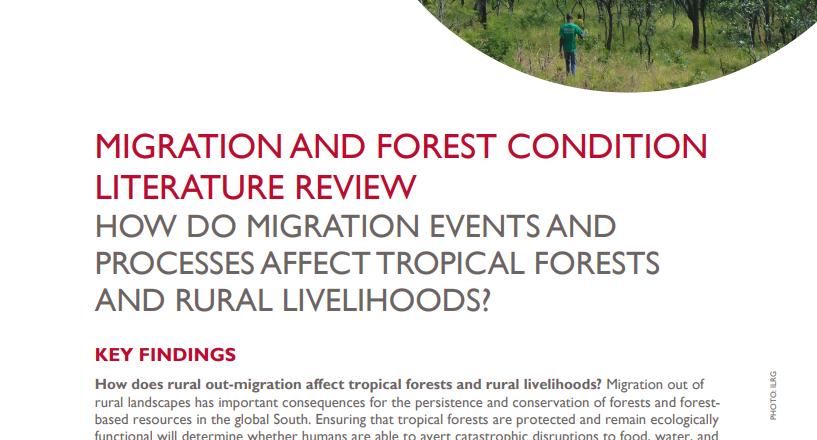Key Findings
How does rural out-migration affect tropical forests and rural livelihoods? Migration out of rural landscapes has important consequences for the persistence and conservation of forests and forestbased resources in the global South. Ensuring that tropical forests are protected and remain ecologically functional will determine whether humans are able to avert catastrophic disruptions to food, water, and energy systems caused by climate change. In some instances, out-migration reduces pressure on forests and forest-based resources and allows for limited natural regeneration of forests in abandoned agricultural parcels. However, in other cases, rapid out-migration of able-bodied laborers weakens local customary land and forest tenure institutions, leading to the mismanagement of forests and an erosion in cultural norms surrounding sustainable use of forest-based resources. Moreover, in most cases, rural out-migration threatens the persistence of rural livelihoods as depopulation results in the loss of ablebodied laborers and subsequent reductions in agricultural production.
The variability in forest outcomes following out-migration makes it difficult to draw broad generalizations from the diverse and disparate case studies available, especially due to the lack of high quality, interdisciplinary or multi-disciplinary studies that couple longitudinal analyses of demographic change with household surveys, spatial data analysis, and ecological surveys of forest condition.
However, some recurring themes and patterns do emerge and can help inform evidence-based interventions that are tailored to a particular geographic region. The recommendations outlined below are not exhaustive and should be carefully considered in the context of local customs, norms, histories, and socioeconomic conditions – if properly implemented, these interventions could increase rural livelihood security and improve forest condition and management.
- Protect and promote forest regeneration through active management – while most landscapes are unlikely to return to pre-disturbance biodiversity levels and ecosystem functioning, these landscapes can provision some ecosystem services including aboveground carbon storage and habitat for wildlife. One possible mechanism to implement this recommendation is through the provision of direct incentives to rural smallholders to actively manage and protect regenerating forests on abandoned agricultural land. These incentives could be created through payments for ecosystem services schemes, carbon finance, or government programs.
- Strengthen customary and communal tenure institutions so that they can adapt to the loss of local participants while still actively managing forests for sustainable use. Labor scarcity and the erosion of cultural norms brought on by rural out-migration threatens the persistence of customary forest and land tenure institutions. Supporting local communities as they build adaptive capacity will be critical to ensure that they continue to manage forests for sustainable use and buffer against the encroachment of large-scale commercial interests. Case studies from Oaxaca, Mexico (Robson & Berkes, 2011) demonstrate that it is possible to build adaptive capacity in customary forest tenure institutions by allowing for flexibility in participation and by ensuring that community members have access to resources for managing forests with a reduced pool of laborers.
- Invest in agricultural extension programs that increase livelihood security for rural smallholders while empowering individuals in their choice to migrate out of or remain on their land. Migration of able-bodied laborers is leading to labor scarcity and a reduction in the cultivation of agricultural land. Subsidies for key agricultural inputs and incentives for crop production would ameliorate some of the pressure caused by out-migration and the loss of laborers for those smallholders who actively choose to continue inhabiting rural landscapes. By providing incentives for smallholders to sustainably intensify their production, these populations can act as a buffer against large-scale land acquisitions for commercial production.
- Invest in improvements in basic services in rural landscapes; access to quality education, health care, and off-farm employment opportunities is needed to empower rural smallholders to make the choice to stay or leave. Protecting rural livelihoods is an important strategy to ensure protection and conservation of tropical forests in conjunction with strong environmental protection policies. While improvements in socioeconomic status or livelihood security of rural smallholders may also lead to an increase in out-migration, investment in improving basic services ensures that individuals and families who wish to remain on their land are better supported in their choice.
- Invest in supporting women-headed households in certain rural landscapes where men make up the majority of outmigrants. Investments in improving tenure security of rural landholdings and supporting the participation of women in customary tenure institutions and both on-farm and off-farm livelihood opportunities can help to alleviate pressure on women-headed households where out-migration is primarily of able-bodied men. Case studies from Nepal (Jacquet et al., 2015) and Oaxaca (Angelsen et al., 2020) point to a lack of support for women-headed households in areas where out-migration of men has shifted the burden of maintaining and cultivating rural landholdings to women. Subsequent loss of productive agricultural land due to labor scarcity is in some cases increasing the socioeconomic precarity of these households and increasing pressure on forest-based resources.


